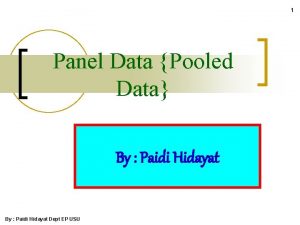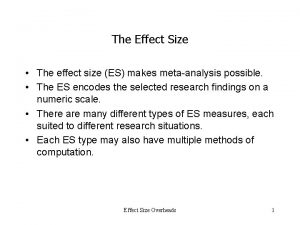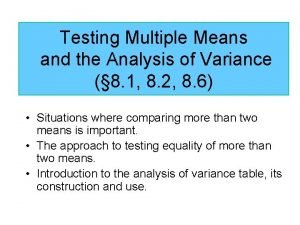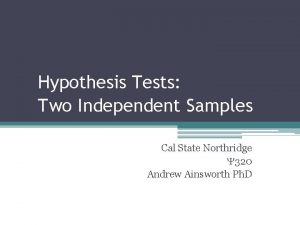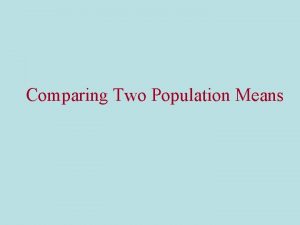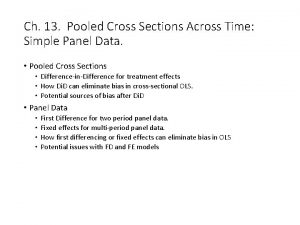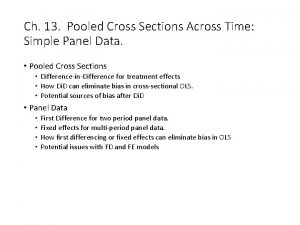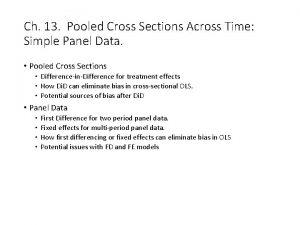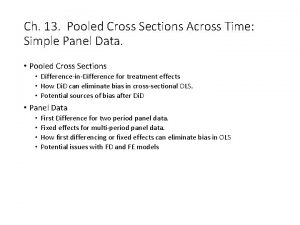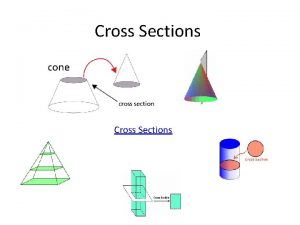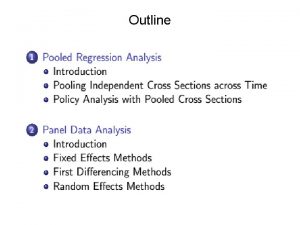Ch 13 Pooled Cross Sections Across Time Simple












- Slides: 12

Ch. 13. Pooled Cross Sections Across Time: Simple Panel Data. • Pooled Cross Sections • Difference-in-Difference for treatment effects • How Di. D can eliminate bias in cross-sectional OLS. • Potential sources of bias after Di. D • Panel Data • • First Difference for two period panel data. Fixed effects for multi-period panel data. How first differencing or fixed effects can eliminate bias in OLS Potential issues with FD and FE models

Pooling Cross Sections across Time: Simple Panel Data Methods • Policy analysis with pooled cross sections • Two or more independently sampled cross sections can be used to evaluate the impact of a certain event or policy change • Effect of new garbage incinerator’s location on housing prices • Examine the effect of the location of a house on its price before and after the garbage incinerator was built: After incinerator was built Before incinerator was built

Pooling Cross Sections across Time: Simple Panel Data Methods • Garbage incinerator and housing prices • Note: near incinerator had negative effect on housing prices before incinerator was built? Why? • Would be inappropriate to interpret negative effect of incinerator after it‘s built as a causal effect. Some of effect is due to fact that incinerator was built near lower price homes. • More appropriate to look at difference-in-difference (Di. D) after incinerator was built: p near – p far = -30, 688. 27 before incinerator was built: = p near – p far = -18, 824. 37 = -11, 863. 9 difference in differences (Di. D)

Pooling Cross Sections across Time: Simple Panel Data Methods • Differential effect of being in the location and after the incinerator was built

Pooling Cross Sections across Time: Simple Panel Data Methods • Policy evaluation using difference-in-differences Compare outcomes of the two groups before and after the policy change

Pooling Cross Sections across Time: Simple Panel Data Methods • Two-period panel data (Fixed Effect) analysis • Example: Effect of unemployment on city crime rate • Assume that no other explanatory variables are available. Will it be possible to estimate the causal effect of unemployment on crime? • Yes, if cities are observed for at least two periods and other factors affecting crime stay approximately constant over those periods: Time dummy for the second period Unobserved city specific time -invariant actors (= fixed effect) Examples of time-constant variables that might affect city crime? Other unobserved factors (= idiosyncratic error)

Pooling Cross Sections across Time: Simple Panel Data Methods • Effect of unemployment on city crime rate • Estimate differenced equation by OLS: Secular increase in crime across all cities. Fixed effect drops out + 1 percentage point unemployment rate leads to 2. 22 more crimes per 1, 000 people

Pooling Cross Sections across Time: Simple Panel Data Methods • Discussion of first-differenced panel estimator • Further explanatory variables may be included in original equation • There may be arbitrary correlation between the unobserved time-invariant characteristics and the included explanatory variables • For example, suppose cities with less educated workers (virtually a time-invariant characteristic) have higher crime and also higher unemployment – how would this bias OLS estimate of effect of unemployment? • First differences cause effect of any time-invariant variables to be differenced out of the regression. Eliminates bias from exclusion of important timeinvariant variables that would emerge in OLS. • First-differenced estimates will be imprecise if explanatory variables vary little over time (no estimate possible if time-invariant)

Panel Data Methods with More than 2 Periods. • Fixed effects estimation Fixed effect, potentially correlated with explanatory variables Form time-averages for each individual Because (the fixed effect is removed) • Estimate deviations from i-specific means using OLS • Estimates rely on time variation within cross-sectional units • (= within estimator) • xtset & xtreg in Stata.

Advanced Panel Data Methods • Example: Effect of training grants on firm scrap rate (number of defective items per 100 produced) Time-invariant reasons why one firm is more productive than another are controlled for. The important point is that these may be correlated with the other explanatory variables. Fixed-effects estimation using the years 1987, 1988, and 1989: Stars denote time -demeaning Training grants significantly improve productivity (with a time lag)

Advanced Panel Data Methods • Discussion of fixed effects estimator • Strict exogeneity in the original model has to be assumed • The R 2 of the demeaned equation is inappropriate measure of R 2 • The effect of time-invariant variables cannot be estimated • The effect of interactions with time-invariant variables can be estimated (e. g. the interaction of education with time dummies) • If a full set of time dummies are included, the effect of variables whose change over time is constant cannot be estimated (e. g. age) • Degrees of freedom have to be adjusted because the individual specific averages are estimated in addition to other coefficients (resulting degrees of freedom = NT-N-k)

Advanced Panel Data Methods (Ch. 14) • Applying panel data methods to other data structures • Panel data methods can be used in other contexts where constant unobserved effects have to be removed • Example: Wage equations for twins Unobserved genetic and family characteristics that do not vary across twins Equation for twin 1 in family i Equation for twin 2 in family i Estimate differenced equation by OLS
 Pooled time series cross-section analysis
Pooled time series cross-section analysis Pooled cross section adalah
Pooled cross section adalah Pooled cross section
Pooled cross section What does the effect size tell us
What does the effect size tell us Kruskal wallis test formula
Kruskal wallis test formula Pooled variance
Pooled variance Pooled variance estimate formula
Pooled variance estimate formula Pooled interdependence
Pooled interdependence Pooled standard deviation
Pooled standard deviation Difference between rdp and sdp
Difference between rdp and sdp Division of florida condominiums
Division of florida condominiums Contoh mediating technology
Contoh mediating technology Subjects and predicates
Subjects and predicates

